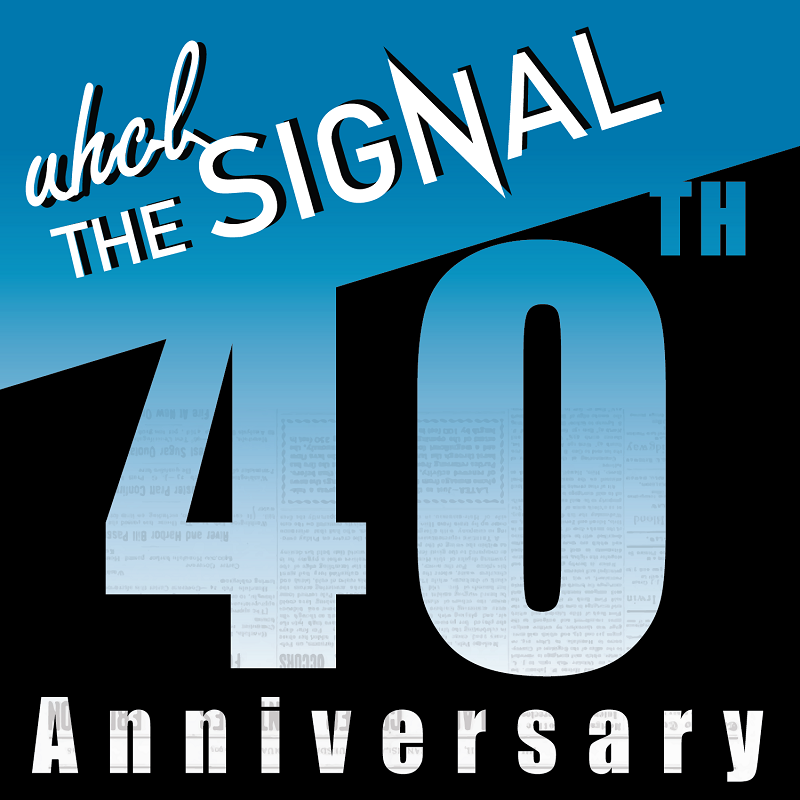The Signal celebrates 40 consecutive years of publication

This October, the student-run newspaper for the University of Houston-Clear Lake (UHCL), The Signal, celebrates 40 consecutive years of publication.
The first issue of the student newspaper was published in May 1975. It was advised by charter faculty member Nan Bruckner, one of the founders of the Women’s Studies program. Bruckner served as the first faculty advisor until 1978 when Gloria Morris, instructor of communication, was hired to teach a class in newspaper publication.
The student newspaper at UHCL started out as a nameless publication. It was not until the fourth issue that a name was determined by a contest in October 1975. The winner of the contest, a grad student named Gene Goodhart, management major, came up with The UHCLidian, which was a homonym for UHCL and the Greek mathematician Euclid.
Gloria Morris served as the faculty advisor for 18 years before retiring in 1996. While she was here, she modernized the paper from a hand-typed mimeographed bond paper format to professional newsprint.
When Morris retired from UHCL, the university hired Patrick Wier as an interim advisor for one year as they conducted a search for Morris’ replacement. In 1997, Ashley Packard, professor in communication and director of student publications, became the fourth faculty advisor for the UHCLidian.
“The late Ashley Packard was a wonderful and powerful force to me,” said Neesha Hosein, former editor of the UHCLidian/TheSignal (2007). “She exemplified all that I hoped to accomplish—career journalist, published writer, book author, professor, a master of her craft. She inspired me, scared me, and taught me what it means to aim for perfection even after I had graduated.”
By 2001, the UHCLidian had begun venturing into the digital world. To supplement the print version of the paper, a website was created by the staff and a PDF version of the publication was posted online for every issue.
In 2002, Packard moved into a vacated spot left by a retiring professor to teach Media Law, Media Ethics, and other communication courses. Taleen Washington, senior lecturer in communications and director of student publications, was hired as her replacement and became the fifth, and current, faculty advisor.
“Taleen Washington was my main source of guidance and advice,” said Hosein. “I spent lots of time in her office brainstorming. I considered her family. Her tough love and shared expertise always forced me to find the best me I could be.”
In 2007, the move toward changing the name from The UHCLidian to The Signal occurred. Many reporters of the publication, students of UHCL and individuals outside of the paper agreed that the name did not suit the professionality the publication was trying to achieve.
“The scope of coverage students wanted to accomplish began to reach outside the campus and the feedback we received on the name was bad,” Washington said. “People commented that the name sounded like a female body part and/or a venereal disease.”
Hosein, who was the editor at the time, launched the name-change campaign.
“I went on foot all over campus collecting opinions from random people regarding the name and what they thought of it,” said Hosein. “I presented my findings and goals to student government and tenured faculty and faced plenty who opposed the name change.”
Washington said the process to change the paper’s name was lengthy and involved.
“The name represented tradition and could not just be changed,” Washington said. “It required every segment of the UHCL population to have a say in the changing of the name.”
After a campus-wide vote, the name The Signal was chosen to represent the progression and transition of the paper into the digital era because it represented both digital and print media.
In January 2014, The Signal went completely digital.
“I had to present my proposal to go completely digital to Dr. Darlene Biggers, the associate vice president of student services, and basically explain why it was time to go digital,” Washington said.
Washington said the cost of print was expensive and by going digital the paper could expand its coverage without significantly increasing its budget. Plus, students were more likely to read the news off their smartphones than pick up a paper.
“We traded the cost of printing for an expanded paid editorial student staff and new technology needed to run the paper,” Washington said.
Initially, the paper ran sporadically then bi-monthly. In spring 2014, it became weekly. The unique hybrid of both communication students working on the paper for course credit (by taking the required capstone course Media Production) in tandem with paid staff members enabled the staff to maintain a weekly schedule.
The Signal has come a long way from a hand-typed newsletter produced on a mimeograph machine to a fully online publication. Brandon Peña, current editor-in-chief of The Signal, has witnessed several of those changes first hand and is hopeful of the paper’s future.
“This is my third year being with The Signal and it has been amazing to see how much we’ve grown in the last few years alone,” Peña said. “Our new tagline, ‘Your Voice, Your Community, Your Signal,’ represents what we, as a student-run newspaper, aims to stand for.”

